Which is the first national park in India? Name: Jim Corbett
Indian forests cover nearly 23% of the landmass and have many ancient forest and wildlife sanctuaries. These forests are home to various indigenous plants and animals. But do you know Which is the First National Park in India?
Ramganga National Park is the 1st national park in India, renamed in 1955 after independence. The park started in 1936 at the Himalayan foothills of the United Province (present Uttarakhand) under Governor Malcolm Hailey as Hailey National Park.
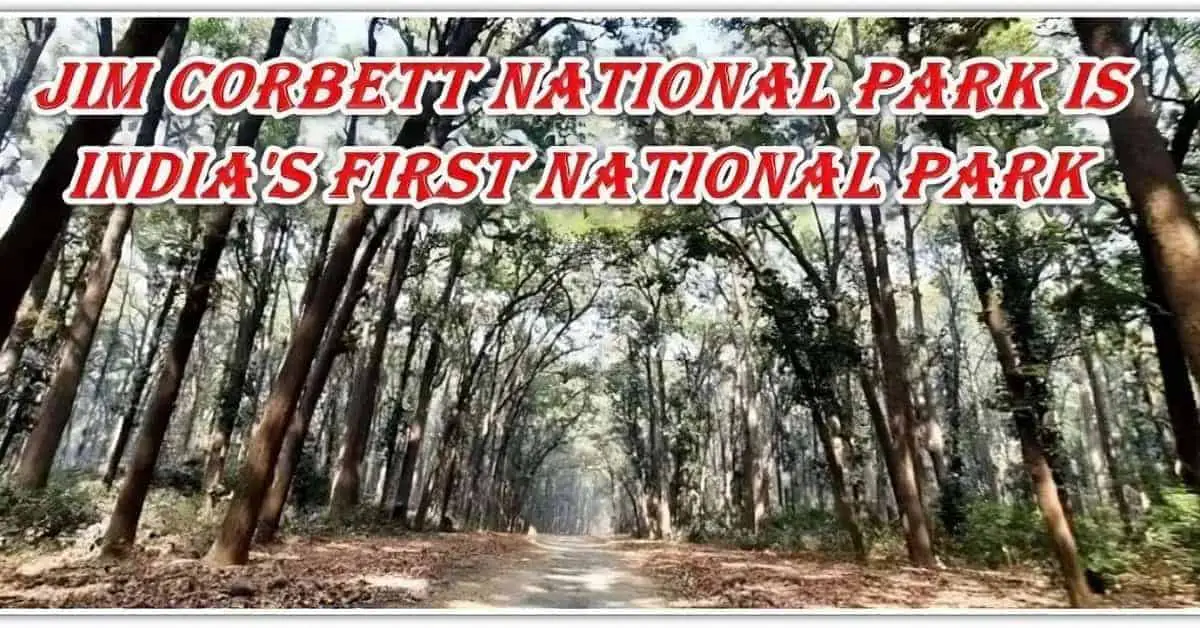
In 1956, Hailey National Park was officially renamed Jim Corbett National Park after the brave hunter and naturalist Jim Corbett. Jim Corbet is known for killing man-eater tigers of this Forest and Wildlife in India and saving the lives of people nearby.
Out of the 104 national parks in our country, Jim Corbett National Park was the first and oldest forest in India and Asia. The Indian Government has always taken active steps to protect the forested lands to stop globalization from robbing nature.
All About Jim Corbett National Park
Jim Corbett National Park’s old name
Jim Corbett National Park was initially named Hailey National Park, later changed to Ramganga National Park and then to its present name. The park is located in the Himalayas foothills.
Where is Jim Corbett located?
The Jim Corbett National Park is 50 km Ramnagar Uttarakhand northwest in Nainital district and Pauri Garhwal district of southern Uttarakhand, pin 244715.
How to reach Jim Corbett National Park
Ramnagar station is the nearest rail station from the Jim Corbett tiger sanctuary in India; the distance is 12 km approx. The distance from Delhi to Jim Corbett is 244.6 km by road. It takes around 5 hours to cover this distance by car. Nainital is 66.8 km away from the national park. Dehradun to Jim Corbett distance is 177.3 km and takes approximately 4 hours by car.
Rules and regulations followed in Jim Corbett National Park
- Visitors must obtain a permit before entering the park.
- Maintain a safe distance from the wild animals.
- Two adults and children (below 12) can accommodate a room in the tourist zone.
- Tourists must wear clothes that will camouflage the surroundings (like olive green, khaki, etc.).
- You must get a clearance certificate before leaving the reserve.
- Driving after sunset is forbidden.
- Visitors must not play transistors and tape recorders and turn down the volume of their phone and stereo.
- Blowing horns and driving above the limit are prohibited.
- Guests are not allowed to cook in the park. Bringing alcohol and non-vegetarian food is not permitted.
- The national park is out of bounds after sunset. Visitors must not enter restricted zones.
- You cannot light a fire or smoke inside the park.
- You must drive vehicles on designated routes. You must not cause damage to any animal or plant.
- Travellers must not litter the park.
- Teasing, shouting, and feeding animals are prohibited.
- Visitors should not use flashlights to capture photos of the wildlife.
- The entry permit is non-transferable.
- Visitors must not get down from the vehicle during the safari.
Jim Corbett National Park Jungle Safari
Like Bhadra Wildlife Sanctuary, the Corbett National Park provides jungle safaris for the best six zones: Bijrani, Jhirna, Dhikala, Dhela, Durgadevi and Sitabani. Types of safaris available in the forest are as follows:
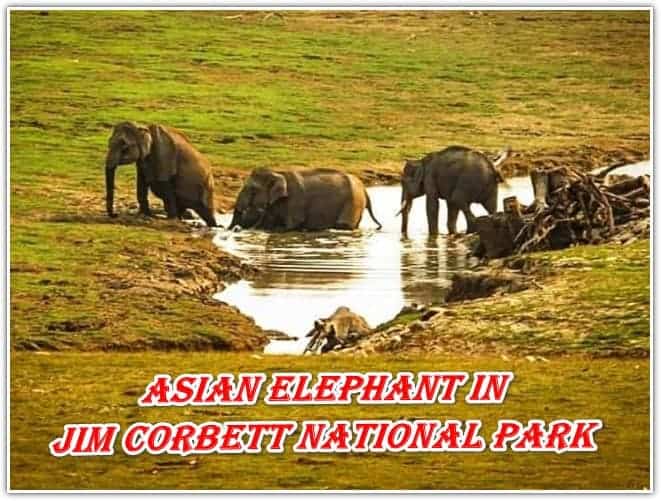
Jim Corbett Elephant Safari
Tourists ride on the back of Indian elephants to explore the mysterious wild. This tour starts from the Durgadevi gate and continues to the Birjani region. After a detailed area tour, the trip ends at Halduparao, on the opposite side. Elephant safari for the Bijrani, Dhikala, and Sitabani zones are available.
| Elephant Safari | |
| Elephant Safari Zones | Jim Corbett Landscape, Dhikala, Bijrani |
| Elephant Safari Timings | 7:00 AM – 9:00 AM and 3:30 AM – 5:30 PM |
| Elephant Safari Price (Indian) | Approx INR 3500 per Elephant ( Maximum 4 Persons are in ONE Elephant |
| Elephant Safari Price (Foreigner) | Approx INR 4500 per Elephant ( Maximum 4 Persons are in ONE Elephant |
The Elephant Safari timings
The Elephant Safari in Jim Corbett Forest has two time slots.
- Morning- 06:00 AM – 08:00 AM
- Afternoon- 04:00 PM – 06:00 PM
Elephant Safari’s duration is approximately 2 hours, reaching the location within 30 minutes.
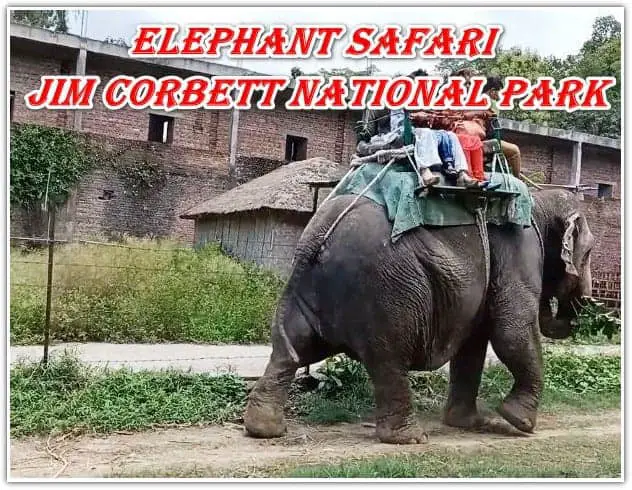
Jim Corbett National Park Jeep Safari
Jeeps are the fastest and most convenient way to go inside the forest. The jeep safari has two different paths. One covers the regions of Bijrani, Sitabani and Jhirna.
The other path tours the entire Durgadevi zone. The safari cost in this zone is slightly higher than in the others. Tourists can book these jeep safaris online for all routes. A maximum of 6 people is allowed in each jeep.
| Jeep Safari | |
| Jeep Safari Timings | Durgadevi / Garjiya /Bijrani / Dhela / Jhirna / Sitabani |
| Jeep Safari Price | 5:30 AM – 9:00 AM and 3:30 PM – 7:00 PM |
| Jeep Safari (Indian) | Approx INR 5000 / – Jeep ( Maximum 6 Persons & 2 children are allowed in ONE Jeep) |
| Jeep Safari Price (Foreigner) | Approx INR 10000 / – Jeep ( Maximum 6 Persons & 2 children are allowed in ONE Jeep) |
Jeep Safari Inclusions: Permission of Jeep, Driver, CTR, Permit and All Entries and Taxes. Guide fees have to be paid by the tourist.
Jeep Safari Timings
The Jeep Safari in Jim Corbett National Park has two time slots.
In Summer
- Morning- 05:30 am – 09:30 am. Last entry 7 am.
- Afternoon- 03:00 PM – 07:00 PM. Last entry 04.30 pm.
In winter
- Morning- 06:30 am – 10:30 am. Last entry 8 am.
- Afternoon- 01:30 PM – 05:30 PM. Last entry 03.00 pm.
Jeep Safari’s duration is approx 3 hours.
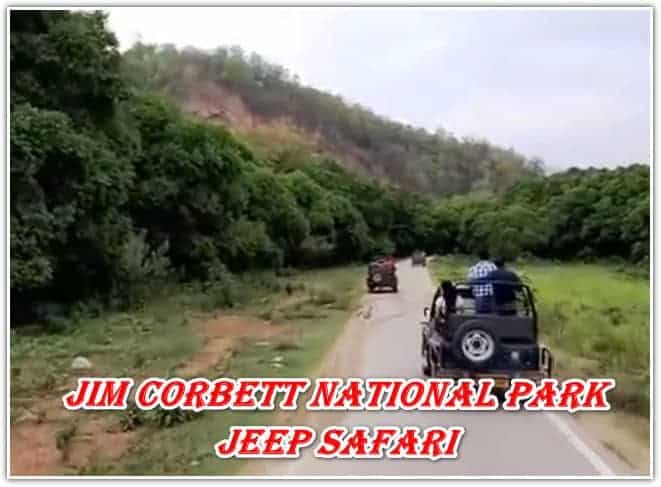
Jim Corbett Canter Safari
Canter is a big bus which can accommodate 16 people at once. The canter safari is used to visit the Dhikala zone and take tourists to their jungle resorts.
| Canter Safari | |
| Canter Safari Zones | Dhikala |
| Canter Safari Timings | 6:00 AM – 11.50 AM and 12:00 PM – 6:00 PM |
| Canter Safari Price (Indian) | Approx INR 1600 / Person ( ONE Canter has 16 Seats ) |
| Canter Safari Price (Foreigner) | Approx INR 3000 / Person ( ONE Canter has 16 Seats ) |
Canter Safari Inclusions: Permission of Jeep, Driver, CTR, Permit and All Entries and Taxes. Guide fees have to be paid by the tourist. No Pick-and-drop service is available from hotels.
Canter Safari Timings
The Canter Safari in Jim Corbett Forest has two time slots.
In Summer
- Morning- 05:00 AM – 11:00 AM.
- Afternoon- 11:30 PM – 05:30 PM.
In winter
- Morning- 06:00 AM – 10:30 AM.
- Afternoon- 11:30 PM – 05:30 PM.
Canter Safari time duration is approx 6 hours long.
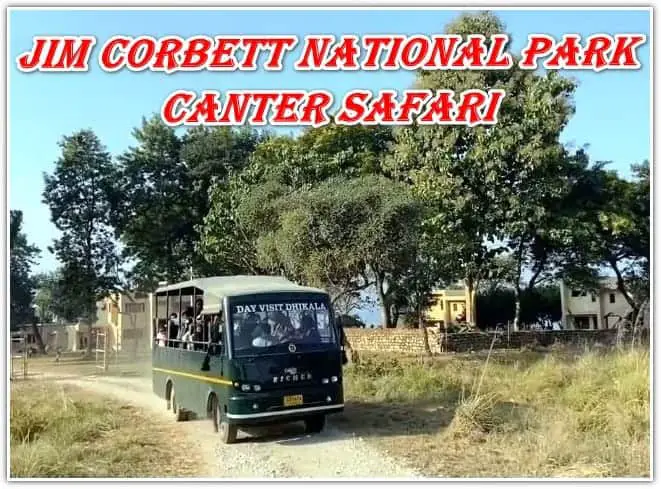
Jim Corbett Wildlife Sanctuary safari online booking
Bookings for these safaris can be made both online and offline. Online booking is made by the park’s website only. Book the safari at least 30 days before getting an available slot. Personal details and ID proof are required during the booking process. Carry the same ID when going on safari for verification purposes.
Jim Corbett National Park visiting hours
Jim Corbett National Park is open weekly from 6:30 AM to 5:30 PM. These timings sometimes change during the winter months.
Read Alipore Zoological Garden Kolkata
Climate and temperature range in Jim Corbett National Park
This forest reserve lies on the foothills of the Himalayas, so the weather here remains colder throughout the year. Winter temperature varies between 5℃ – 25℃. The average temperature in summer is 30℃. Heavy rainfall occurs from July to September.
Best time to visit Jim Corbett National Park
October to February is the best time to plan your trip to the Corbett National Park. All zones of the park remain open at this time. The temperature ranges from 5℃ – 25℃ during this time. Precipitation is zero. The cold, dry winter weather makes it easier to explore the forest.
The majority of the forest allows visitors from mid-November to June. While most of the forest remains closed during the monsoon, the Jhirna zone keeps its doors open throughout the year. The Bijrani zone, however, is open from October to June.
Monsoons can be dangerous due to floods and frequent landslides. So avoiding that part of the year is a good idea.
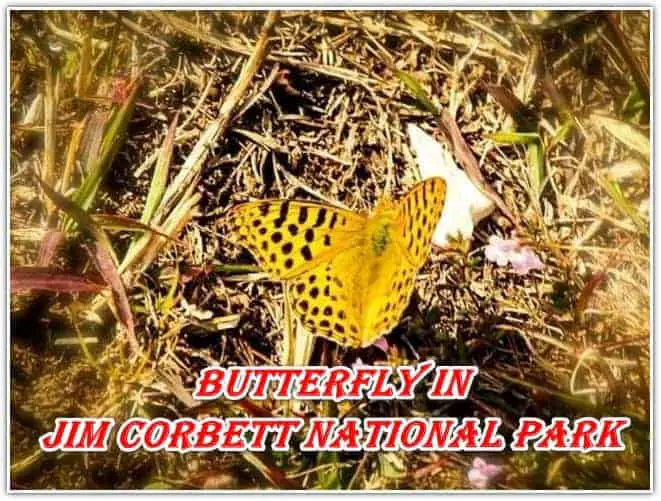
Jim Corbett National Park closing dates
The core zones remain closed from 15th June to 15th November, while the Bijrani zone is closed till 15th October. The buffer zone remains open throughout the year.
Read Ballavpur Wildlife Sanctuary | Deer Park Bolpur West Bengal
Best resorts and hotels in Jim Corbett National Park
The Jim Corbett National Park has remained a popular tourist spot since the mid-90s. It’s an important centre of Uttarakhand tourism. Thus, the state government has actively participated in developing the area for tourist accommodation.
You can find a variety of resorts and hotels in Gym Corbett Jungle, from luxurious forest resorts to budget hotels. The hotels and forest lodges are mostly concentrated in the buffer zone or outside the main forest. Some lodges are also inside the different zones, such as:-
Dhikala forest lodge
It’s a government-maintained forest rest house with all basic amenities provided. Rooms are limited, so you must book online before the trip. In the middle of the Dhikala zone, there is a high chance of seeing animals from the lodge balcony. You can manage food from the canteen which is open all day long. There is also a restaurant on the same campus.
Gairal rest house
The Gairal rest house is in a remote area with few modern amenities. It’s not a place for maximum comfort, but you can experience the raw beauty of nature while staying here. The hotel is powered by solar cells. Staff working are mainly native to the area and have excellent forest knowledge.
Sarapduli Forest Rest House
Sarapduli Forest Rest House is located in the deepest part of the Dhikala zone. The Ramganga River flows near this hotel, and tourists often see a gharial resting on the ground from the window. There is a shared kitchen where you can cook food or provide ingredients for the chef to cook. Power is provided through solar panels and inverters. There are two rooms – a double bed and one triple bedroom.
There are also luxury hotels like Corbett Leela Vilas, Infinity Resort, Corbett River View Retreat, etc. They are in the outer boundary of the forest or the buffer zone. These hotels get proper power supply and are equipped with high-end luxury items and facilities like TV, AC, swimming pool, etc.
Jim Corbett National Park is famous for which animal
The 1st National Park of India ( Jim Corbett ) is 521 square kilometres large and has many flora and fauna. Under Project Tiger, this tiger sanctuary became the first tiger reserve in India because of its impressive population of the Royal Bengal Tigers. Even today, Jim Corbett has the most protected tigers among India’s forests.
According to the latest survey, there are of tigers inside the reserve is 252. Dhikala and Bijrani are the best zones for tiger sightings. Other mammals and reptiles can also be found here.
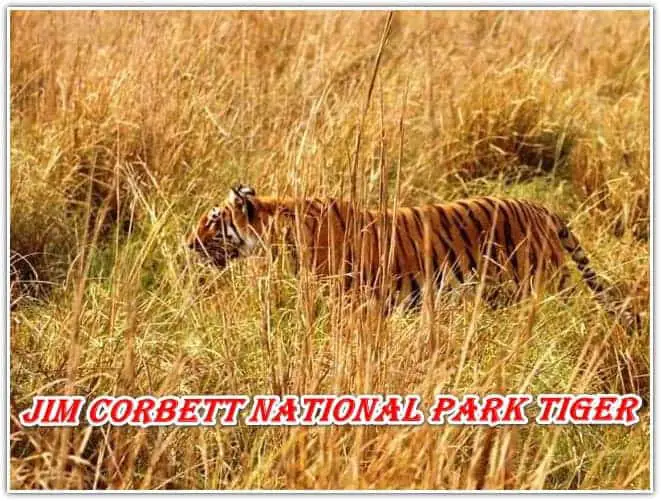
Birds in Jim Corbett National Park
The Durgadevi zone is a well-known bird-watching destination. Bird watchers from all around visit Jim Corbett National Park to study different avian species and admire their appearance. Peacock, Jungle fowl, Partridge, Khaleej pheasant, Drongo, Duck, Teal, Stork etc., are the common birds in Sultanpur National Park.
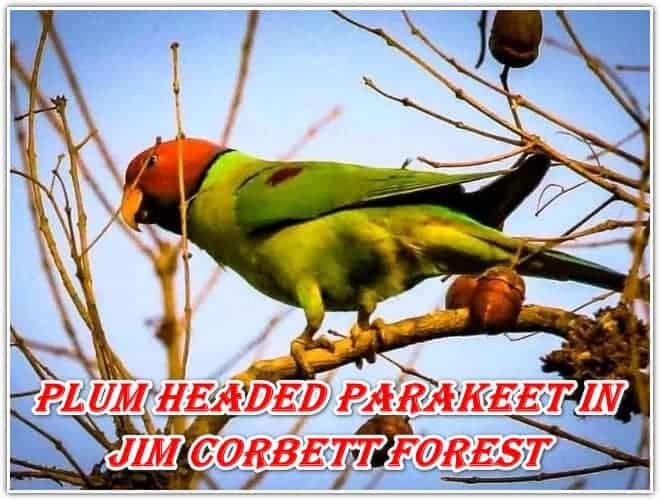
Jim Corbett National Park tiger population
Jim Corbett National Park has the highest number of Royal Bengal Tigers out of all other forests in India. This year, it increased by 21, making the total number of inhabitant tigers 252. Apart from that, 14 tigers regularly visit the protected forest area from the nearby mountains.
International Tiger Day
Tigers are the mighty beasts of the jungle who often fall prey to the hands of humans and lose their lives. In the 19th and early 20th centuries, the rich and royalties exploited this species to endanger their existence. As a result, tigers came to the brink of extinction in the early 2000s.
In 2010, the idea of International Tiger Day emerged at the Saint Petersburg Tiger Summit in Russia. We celebrate this day on 29th July to raise awareness towards tiger conservation. Today, the tiger population is in a much better position, clearly showing us the importance of this day.
Corbett Tiger Reserve (CTR)
The Corbett Tiger Reserve is the first Tiger reserve in the country, and it looks after the health and well-being of the Royal Bengal Tigers in the Jim Corbett National Park. Currently, 252 tigers are tended to and monitored for the sake of conserving the tiger population.
Endangered species in Jim Corbett National Park
This forest is mainly responsible for preserving India’s national animal, the Tiger, as its population decreases. Another endangered mammal found here is the Asiatic Elephant. The park also preserves Gharial, an endangered reptile, the oldest living crocodilian.
Flora and Fauna of the First National Park in India
Jim Corbett National Park is an intoxicating wonder of nature. Rolling hills, vast grasslands, reveries and tall deciduous trees make up this moist deciduous forest. Sal, Mango, Peepal, Rohini, and Haldu trees comprise more than 70% of the landmass.
The Royal Bengal Tigers are the representative animal here. Mammals apart from Tigers are Langur, Wild Boar, Asian Elephants, Jackal, Leopard and different species of Deer like Sambar, Barking Deer, Nilgai etc. Crocodiles, Pythons, King Cobras, Russel vipers, and lizards are the prominent reptile family members found here.
The Jim Corbett National Park is in the Himalayan mountains and has many water bodies. We can observe a variety of flora or natural vegetation here. Out of these, freshwater flora and alpine flora are the dominating ones. The alpine flora is less near the entrance, and deeper into the forest grows more.
Common trees are Sal forests, Chaurs, Khair, etc. We can see the freshwater plants near the Ramganga River. Freshwater vegetation is Polygonum, Veronica, Hypericum, Ranunculus, etc. There are over 600 plant species in this park.
Trees in Jim Corbett National Park
Corbett National Park is mainly a deciduous forest. Therefore, prominent trees here are Sal, Shimal, Kharpat, Sissoo, Khair, etc. You can see Conifers around the elevated ridges in a tiny portion of the park. The only conifer species in the park premises is Chir pine (Pinus roxburghii).
Banj oak (Quercus leucotrichophora) is an exclusive Himalayan tree found here. Palm and date are some common fruit-bearing trees. There are some flowering trees like Shimul, Madaar, Dhak, etc. You can also find some Teak, Eucalyptus, Jacaranda, and Silver Oak, among others. Bamboo plantations occupy a vast portion of the forest.
Flowering Trees
Trees like Kachnar (Bauhinia variegata), Dhak (Butea monosperma), Shimul (Bombax ceiba), Madaar (Erythrina indica), and others liven up the forest with their colourful flowers. Kachnar or Bauhinia variegata bears pink and white flowers, while Shimul flowers cover the tree in bright red.
Dhak has a fiery bright orange, which is named Flame-of-the-forest. Indian Coral or Madar flowers have a beautiful mixture of red and orange. Its long and sleek petals combine to give the flower an elegant look. Amaltas (Cassia fistula) is another flowering tree with chandelier-shaped bright yellow flowers.
Shrubs
Shrubs are mainly found on the bank of the Ramganga River, and castor bushes are planted here to feed animals. Maror Phali, Karaunda, and Hisar are three noticeable fruit-bearing shrubs of this region. Karaunda also bears beautiful pink wildflowers. There are 51 species of shrubs recorded in this area.
Bamboo
The Jim Corbett National Park is known for its different bamboo plants; more than 33 varieties are found here. Dendrocalamus strictus or Male bamboos are more pronounced than females. The peculiar growth process of bamboo can be observed well here.
Jim Corbett National Park packages
Different tourism organisations offer several tour packages. These include detailed itineraries about each day. Buying a tour package will ensure safe travelling, and you will be able to finish all the activities within the given time. Some popular tour packages offered by the official website of Jim Corbett National Park are as follows:
Special Wildlife tour (Dhikala)
The tour duration is two nights and three days. The cost for two adults is Rs 21400. Food, accommodation and safari are included.
Imperial Wildlife tour (Dhikala and Bijrani)
The tour duration is three nights and four days. The cost for two adults is Rs 30700. Stay at the forest rest house. All facilities are included in the package.
Royal and adventurous tour for Whole Park visit (Dhikala and Bijrani)
The tour duration is four nights and five days. The cost for two adults is Rs 39700. Stay at a luxury hotel outside the core area and the forest resort inside the Bijrani zone. All meals and safaris are covered, too.
16 places to visit near Jim Corbett National Park
While touring the forest for animals, visit the nearby tourist spots to learn more about the place and its culture.
- Garjiya Temple Ramnagar Uttarakhand
- Corbett Falls Nainital
- Corbett Museum Kaladhungi
- Sona Nadi Range
- Kyari Camp
- Ramganga Dam Uttarakhand
- Dhangarhi Museum
- Kosi River
- Sitabani Temple and Wildlife Reserve
- Bhowali Uttarakhand
- Gujru Garhi
- Hill Station near Kathgodam
- Nainital tourist spots
- Bhimtal hill station and lake
- Sattal lakes
- Mukteshwar Temple
Garjiya Temple Ramnagar Uttarakhand
Garjiya Temple is a famous Shakti Shrine of the state. This beautiful temple was constructed on top of a rock in the middle of the Kosi River. It takes around 30 minutes to reach this holy temple from the Ramnagar bus stand. The occasion of Kartik Poornima is a mighty affair here. A big fair is organised for the thousands of devotees who attend during this time.
Corbett Falls eco park Nainital
Corbett Falls provides a picturesque view of white water from the Barhani Range. It has become a popular picnic spot. Kaldhungi is the closest region to the falls at a distance of 4 km. To reach the falls, tourists have to trek a short distance of 1.5 km.
Corbett falls timings and entry fee
The entry time is 8 am to 5 pm. It was closed in July and September for rainfall. The entry fee is 50 rupees per person. The Wheelers charge is 100 rupees.
Corbett Museum Kaladhungi
The house of great naturalist Jim Corbett is now a heritage museum. It’s dedicated to the bravery of this renowned hunter with his items displayed here. It’s near Kaladhungi at Choti Haldwani inside the park premises. Entry ticket costs rupees 10 for Indians and rupees 15 for foreigners.

Sona Nadi Range
Sonanadi Wildlife Sanctuary, a part of the Corbett National Park, is home to the beautiful Sona Nadi range. Tourists visit this range for its spectacular scenic beauty and the various species of birds.
Kyari Camp
To the east of the Kosi River is the Kyari village, where you can find this exciting Kyari Camp. Experience camp life with leisure activities like rock climbing and river rafting here.
Ramganga Dam Uttarakhand
The Ramganga Dam is an embankment dam constructed on the Ramganga River. Due to its close vicinity to Kalagarh, it’s also known as the Alagarh Dam. It was constructed by Uttarakhand Jal Vidyut Nigam Limited in 1974. The view of the forest from the dam is calm and peaceful.
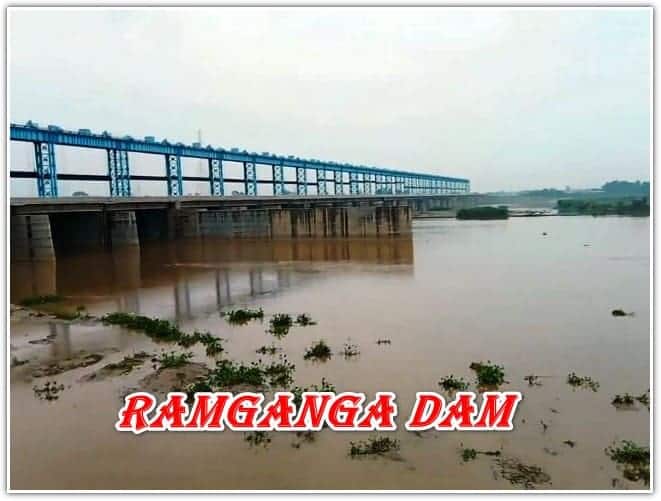
Dhangarhi Museum
Near the Dhangarhi gate is the Dhangarhi Museum, among the oldest structures on the grounds of Corbett. It showcases the life and work of Jim Corbett and also artworks inspired by the forest. The entry fee is 10 rupees for everyone.
Kosi River
Kosi River is the main river flowing through the forest. It originates from Dharpani Dhar at Almora. It’s perennial and the primary water source for the wildlife in the park. It also provides water for farming in the nearby villages. Visiting the riverside at the end of the day might result in a wild animal encounter.
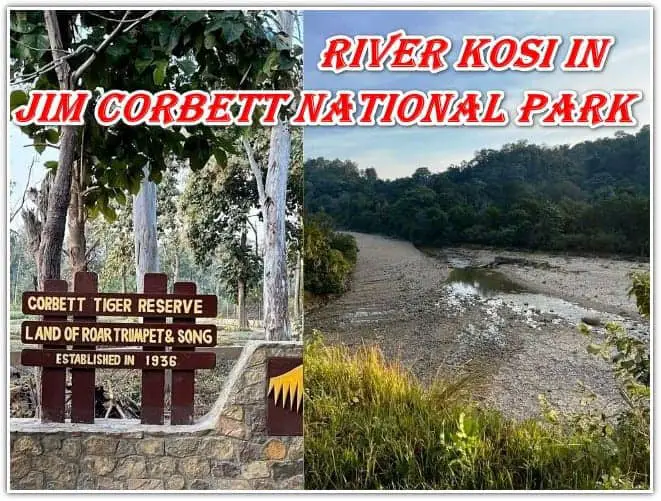
Sitabani Temple and Wildlife Reserve
It’s a temple dedicated to the Ramayana character Sita. According to local legends, Sita spent her life in exile before Agnipariksha. At present, it’s a holy place among Hindus, with many devotees visiting it every day. Along with the temple, visitors can enter the wildlife reserve too.
Bhowali Uttarakhand
It’s a toy town in the centre of the Nainital district. A wonder of nature in the Kumaon Valley, this town is famous for its most refined production of fruits like apricots, strawberries, peaches, etc.
Gujru Garhi
Gujru Garhi is a temple on the highest point of Nainidanda hill station. It’s a historical fort with some prehistoric caves residing at its side. This historical site is at a height of 2,400 m from sea level. During winter, this place becomes hard to access due to heavy rainfall. Tourists often indulge in a hike to reach the temple.
Hill Station near Kathgodam
Kathgodam has the most famous hill stations in Uttarakhand. The town is situated at an elevation of 1,817 ft above sea level on the banks of the Gaula River. Kathgodam means timber depot, and thus it is a top centre for the collection of forest products in the region.
Nainital tourist spots
The beautiful hill station of Nainital attracts thousands of tourists to Uttarakhand every year. It’s a popular tourist-friendly place. You can find many shops selling local goods here. The town gets its name from the beautiful eye-shaped Naini Lake, the main attraction here.
Bhimtal hill station and lake
Bhimtal is another lake city near Nainital. It’s a lesser-known town compared to Nainital. Lake Bhimtal sits at the centre of this town and is known for its scenic beauty. There is a small island in the middle of the lake with an aquarium for informative purposes.
Sattal lakes
Sattal is a wonder of nature found in the Kumaon. It’s an interconnection of seven taals or lakes at 1370 mt above sea level. The name translates as “Seven Lakes”. It’s surrounded by dense forests all around. This linkage of lakes is an excellent place for bird watching.
Mukteshwar Temple
Mukteshwar is an exotic hill station situated 2,285 mt above sea level in Nainital. The beauty of Mukteshwar is in its serenity. Being surrounded by the Himalayas, the town is somewhat secluded from the general tourist crowd. It’s perfect for a calming vacation in the hills.
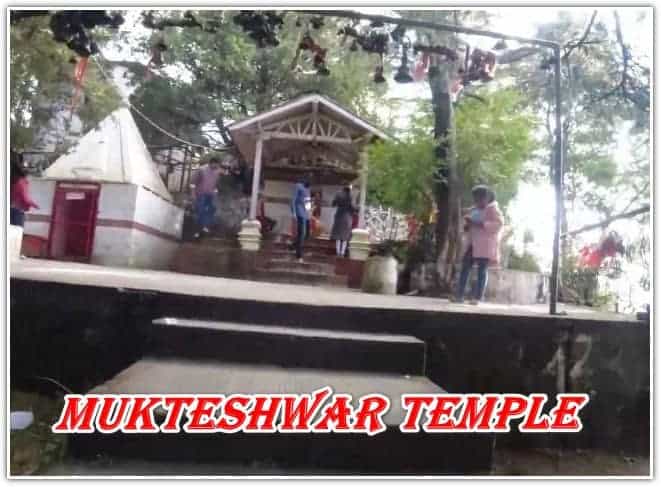
Total National Park in India
The latest survey said India has 104 national parks now. With global warming harming our plant and animal lives, their safeguarding has been carried out by establishing protected reserves. Indian forests are turned into national parks, wildlife sanctuaries, reserve forests, etc.
World’s first National park
World’s First National Park The world’s first national park was established in the USA as Yellowstone National Park. It was built in 1872. President Ulysses S. Grant announced the formation of this park to protect the land from private investors.
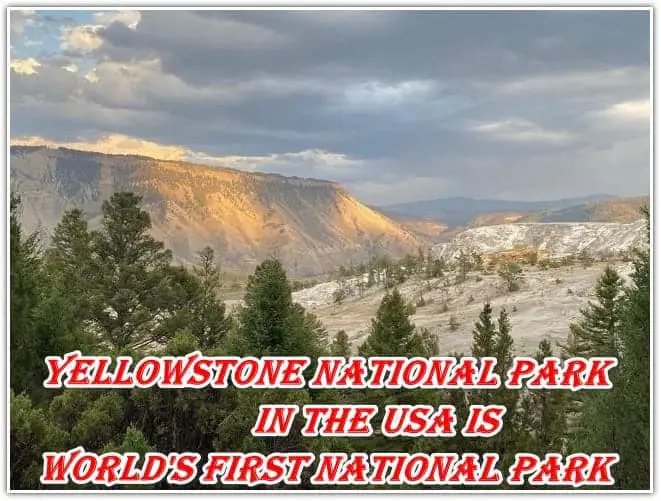
Read All about Epping Forest and 9 walks
Largest national park in India
Largest national park in India In the widespread barren lands of Ladakh valley in Jammu & Kashmir is the largest national park in India – Hemis National Park. It’s 4400 sq km large. It was established in 1981 and named after the adjacent Hemis Monastery. It’s home to Snow Leopards.
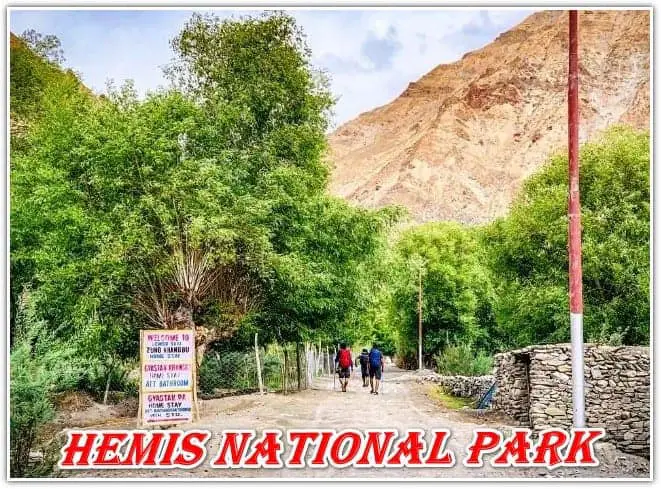
Smallest national park in India
The smallest national park in India is the South Button Island National Park. It’s in the Andaman and Nicobar Islands and covers a total area of 0.44 sq km.
This park is an extension of the Rani Jhansi Marine National Park. Sea creatures like Dolphins, Blue whales, sea turtles, etc., are protected here.

What is the nearest railway station to Jim Corbett National Park?
Ramnagar railway station is the closest railway station to Corbett National Park. Trains from important cities like Delhi, Lucknow, Chennai etc.
Which river flows through Jim Corbett National Park
Ramganga, Kosi and Sonanadi are the three main rivers flowing through this forest.
Which animal is protected in Jim Corbett National Park
The Royal Bengal tiger is protected in this park under the Project Tiger Initiative.
How many gates are in the Jim Corbett National Park?
The park has four gates to enter. The four gates are the Dhangadi (Dhikala zone) gate, Amdanda (Bijrani zone) gate, Jhirna (Zhirna zone) gate, and Durga Devi (Lohachaur zone) gate. Entry timing through a particular gate is fixed, so visitors must have advance permission.
Which jeep safari is best in Jim Corbett National Park, morning or afternoon, during the first week of November?
In the first week of November, the weather remains chilly. Tourists can’t see things properly because of the thick fog. Thus, a jeep safari in Jim Corbett National Park during the afternoon is recommended.
Information about Peacock of Jim Corbett National Park
Jim Corbett National Park houses many animals, flora and fauna. The national park has more than 650 species of birds (resident and migratory). The sight of India’s national bird, the Peacock, in Jim Corbett National Park is a delight for bird watchers.
Is it mandatory to wear shoes in Jim Corbett National Park?
Wear comfortable shoes while on a Jim Corbett National Park safari. When visiting Jim Corbett National Park, you will contact many poisonous and harmful insects and bushes.
Thus, wearing clothes covering your entire body, especially shoes, is essential. These forests grow in North Indian states and the Middle East Himalayas (upper & middle altitudes).
Conclusion
Jim Corbett National Park (First National Park of India) is the perfect place to break from the fast-paced city life, from the dense forest to the vast grasslands and riversides. It’s perfect for both solo and group trips. The quiet and calm of forests will fill your life with serenity, while the excitement from adventure activities will be like a breath of fresh air. Jim Corbett is a place with the perfect balance needed for a great trip.
Forest Articles:-
- Valki Machan Tour | Kolkata to Valkimachan Bardhaman West Bengal
- Gurgaon Sultanpur Bird Sanctuary timings, entry fee
- Where is Betla National Park? Address, Timings, Entry Fee
- Chintamani Kar bird sanctuary
- Tropical and Subtropical Dry Broadleaf Forests
- Gir National Park in Gujarat is famous for which animal?
- Different Types of Forests in India
- How to reach Ranthambore National Park
- Turahalli Forest cycling trails, trekking, hiking, bike ride